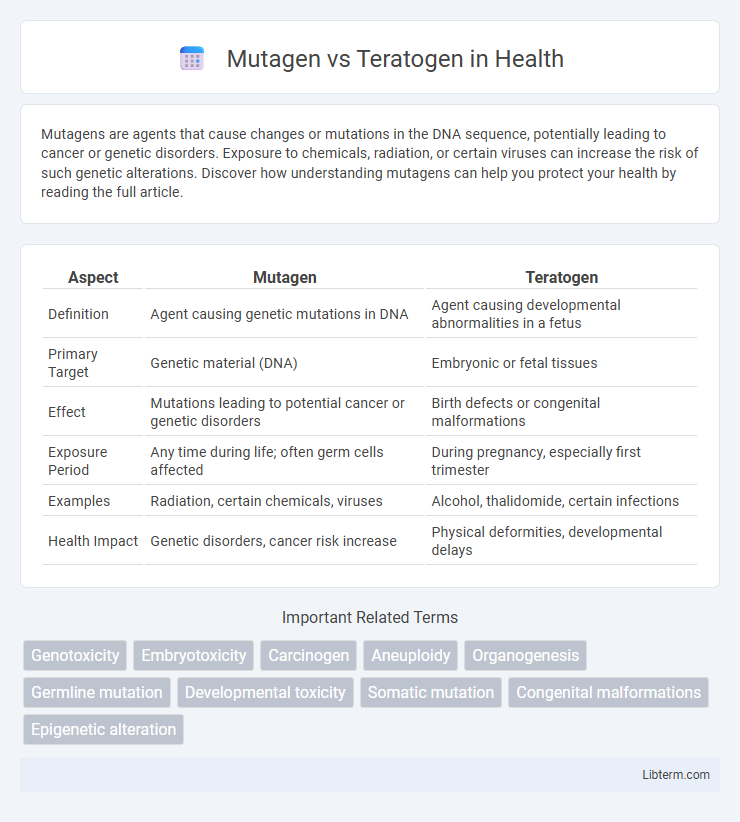Mutagens are agents that cause changes or mutations in the DNA sequence, potentially leading to cancer or genetic disorders. Exposure to chemicals, radiation, or certain viruses can increase the risk of such genetic alterations. Discover how understanding mutagens can help you protect your health by reading the full article.
Table of Comparison
| Aspect | Mutagen | Teratogen |
|---|---|---|
| Definition | Agent causing genetic mutations in DNA | Agent causing developmental abnormalities in a fetus |
| Primary Target | Genetic material (DNA) | Embryonic or fetal tissues |
| Effect | Mutations leading to potential cancer or genetic disorders | Birth defects or congenital malformations |
| Exposure Period | Any time during life; often germ cells affected | During pregnancy, especially first trimester |
| Examples | Radiation, certain chemicals, viruses | Alcohol, thalidomide, certain infections |
| Health Impact | Genetic disorders, cancer risk increase | Physical deformities, developmental delays |
Introduction to Mutagens and Teratogens
Mutagens are agents that cause changes or mutations in the DNA sequence, potentially leading to genetic disorders or cancer. Teratogens are substances that disrupt normal fetal development, causing birth defects or malformations during pregnancy. Both mutagens and teratogens pose significant risks to genetic integrity and embryonic growth, highlighting the importance of understanding their effects in toxicology and developmental biology.
Defining Mutagens: Mechanisms and Effects
Mutagens are agents that cause permanent genetic alterations by inducing DNA mutations such as base pair substitutions, insertions, or deletions, leading to changes in the genetic code. These changes can result from chemical, physical, or biological factors that disrupt DNA replication or repair mechanisms, increasing the risk of genetic disorders and cancer. Unlike teratogens, which affect embryonic development, mutagens directly impact the genome, potentially causing heritable mutations across generations.
Understanding Teratogens: Types and Impacts
Teratogens are agents that cause congenital malformations or increase the incidence of birth defects during fetal development, with types including drugs, chemicals, infections, and radiation. Common teratogens such as thalidomide, alcohol, and rubella virus disrupt normal embryonic growth by interfering with cell differentiation and organ formation. The impact of teratogens depends on dosage, timing during pregnancy, and genetic susceptibility, often resulting in physical abnormalities, neurodevelopmental disorders, or functional deficits.
Key Differences Between Mutagens and Teratogens
Mutagens are agents that cause genetic mutations in DNA, potentially leading to cancer or hereditary diseases, while teratogens specifically disrupt fetal development, resulting in birth defects or malformations. Mutagens primarily affect cellular genetic material across various life stages, whereas teratogens impact embryonic and fetal growth during critical periods of pregnancy. Common mutagens include chemicals like benzene and radiation, whereas teratogens encompass substances such as thalidomide and alcohol.
Sources and Examples of Common Mutagens
Common mutagens include ultraviolet (UV) radiation from the sun, which causes DNA damage leading to mutations, and chemical agents like benzene, formaldehyde, and certain pesticides found in industrial waste and tobacco smoke. Natural sources also comprise aflatoxins produced by molds on improperly stored grains and nuts. Ionizing radiation from X-rays and radioactive materials represents another critical mutagenic source impacting genetic material across various organisms.
Common Teratogens and Their Origins
Common teratogens include alcohol, which originates from excessive maternal consumption during pregnancy, leading to fetal alcohol spectrum disorders; thalidomide, a drug once prescribed for morning sickness but causing limb defects; and certain infections like rubella virus, transmitted from mother to fetus causing congenital abnormalities. Environmental chemicals such as lead and mercury, often found in contaminated water and industrial pollutants, also pose significant risks to fetal development. These teratogens disrupt normal embryonic growth by interfering with cell division, differentiation, or organ formation, resulting in structural or functional birth defects.
Genetic vs. Developmental Consequences
Mutagens cause genetic alterations by inducing changes or mutations in the DNA sequence, which can lead to hereditary defects or cancer. Teratogens impact embryonic development without directly altering genetic material, causing structural or functional malformations during fetal growth. Understanding the distinction is critical for assessing risks related to gene mutations versus developmental abnormalities in prenatal health.
Human Health Risks: Mutagens vs. Teratogens
Mutagens cause genetic mutations by altering DNA sequences, increasing the risk of cancer and hereditary diseases in humans. Teratogens interfere with fetal development, leading to congenital malformations and developmental disorders during prenatal stages. Understanding these risks is critical for public health strategies aimed at minimizing exposure to chemical, physical, and biological agents in the environment.
Prevention and Safety Measures
Preventing exposure to mutagens and teratogens involves strict adherence to safety protocols in workplaces handling chemicals, radiation, and pharmaceuticals known to cause genetic or developmental damage. Use of personal protective equipment (PPE), proper ventilation, and regular monitoring of environmental contaminants significantly reduce risk. Public health guidelines recommend avoiding smoking, alcohol, and unprescribed medications during pregnancy to minimize teratogenic effects, while proper disposal and regulation of hazardous substances mitigate mutagenic hazards.
Conclusion: Navigating Mutagenic and Teratogenic Risks
Navigating mutagenic and teratogenic risks requires understanding that mutagens cause genetic mutations potentially leading to cancer, while teratogens result in developmental malformations during pregnancy. Effective risk assessment demands identifying exposure sources, such as chemicals, radiation, or drugs, and implementing protective measures to minimize harm. Prioritizing early detection and preventive strategies enhances public health by reducing genetic and developmental damage.
Mutagen Infographic

 libterm.com
libterm.com